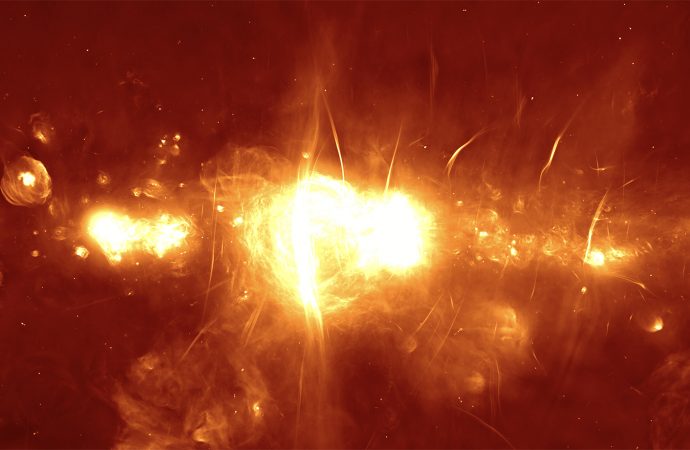Deputy President of the Republic of South Africa, Mr David Mabuza, today officially inaugurated the MeerKAT radio telescope.
After a decade in design and construction, this project of South Africa’s Department of Science and Technology has now begun science operations. At the launch event, a panorama obtained with the new telescope was unveiled that reveals extraordinary detail in the region surrounding the supermassive black hole at the centre of our Milky Way Galaxy. This is one of several very exciting new views of the Universe already observed by the telescope.
“We wanted to show the science capabilities of this new instrument”, says Fernando Camilo, chief scientist of the South African Radio Astronomy Observatory (SARAO), which built and operates MeerKAT in the semi-arid Karoo region of the Northern Cape. “The centre of the galaxy was an obvious target: unique, visually striking and full of unexplained phenomena – but also notoriously hard to image using radio telescopes”, according to Camilo. The centre of the Milky Way, 25,000 light-years away from Earth and lying behind the constellation Sagittarius (the “Teapot”), is forever enshrouded by intervening clouds of gas and dust, making it invisible from Earth using ordinary telescopes. However, infrared, X-ray, and in particular, radio wavelengths penetrate the obscuring dust and open a window into this distinctive region with its unique 4 million solar mass black hole. “Although it’s early days with MeerKAT, and a lot remains to be optimised, we decided to go for it – and were stunned by the results.”
“This image is remarkable”, says Farhad Yusef-Zadeh of Northwestern University in Evanston, Illinois, one of the world’s leading experts on the mysterious filamentary structures present near the central black hole but nowhere else in the Milky Way. These long and narrow magnetised filaments were discovered in the 1980s using the Very Large Array (VLA) radio telescope in New Mexico, but their origin has remained a mystery. “The MeerKAT image has such clarity”, continues Yusef-Zadeh, “it shows so many features never before seen, including compact sources associated with some of the filaments, that it could provide the key to cracking the code and solve this three-decade riddle”.
Yusef-Zadeh adds that “MeerKAT now provides an unsurpassed view of this unique region of our galaxy. It’s an exceptional achievement, congratulations to our South African colleagues. They’ve built an instrument that will be the envy of astronomers everywhere and will be in great demand for years to come”.
About MeerKAT
MeerKAT is a South African project, a precursor to the larger international Square Kilometre Array (SKA). It is managed by the South African Radio Astronomy Observatory (SARAO), where most of the specialised hardware and associated software was designed and built in cooperation with industrial partners. MeerKAT consists of 64 antennas (or dishes), each 13.5 meters in diameter, located on baselines (distances between antenna pairs) of up to 8 km. The dishes are of a highly efficient design with up to four cryogenic receiver systems operating in different bands of the radio spectrum. The first installed set of receivers operates between frequencies of 900 MHz and 1670 MHz. The vast amounts of data from the 64 dishes (up to 275 Gbytes per second) are processed in real time by a “correlator”, followed by a “science processor”, both purpose-built. After further offline analysis, images of the radio sky are generated. Eventually, MeerKAT will be incorporated into Phase 1 of the SKA-MID telescope.
Source: SKA.ac.za

































Leave a Comment
You must be logged in to post a comment.